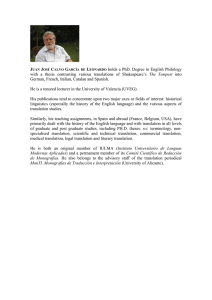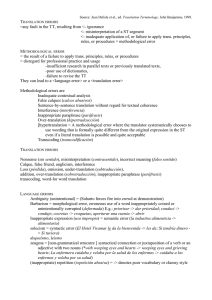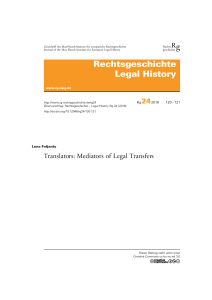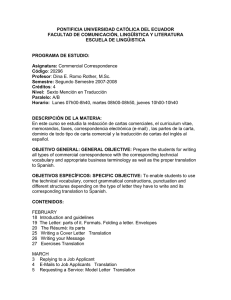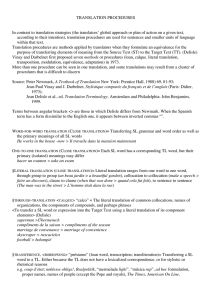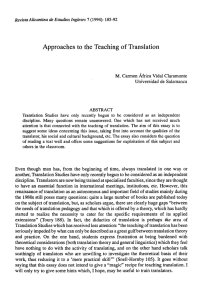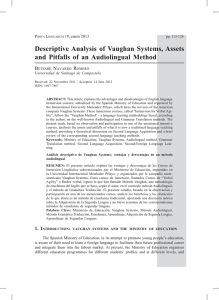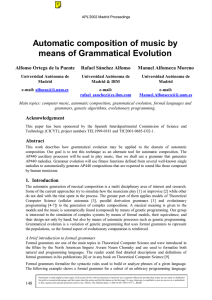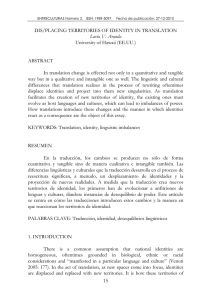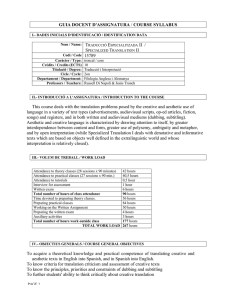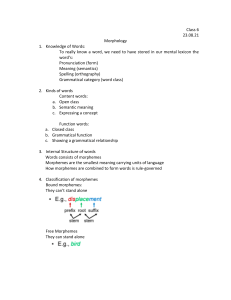Grammar Translation Method
Anuncio
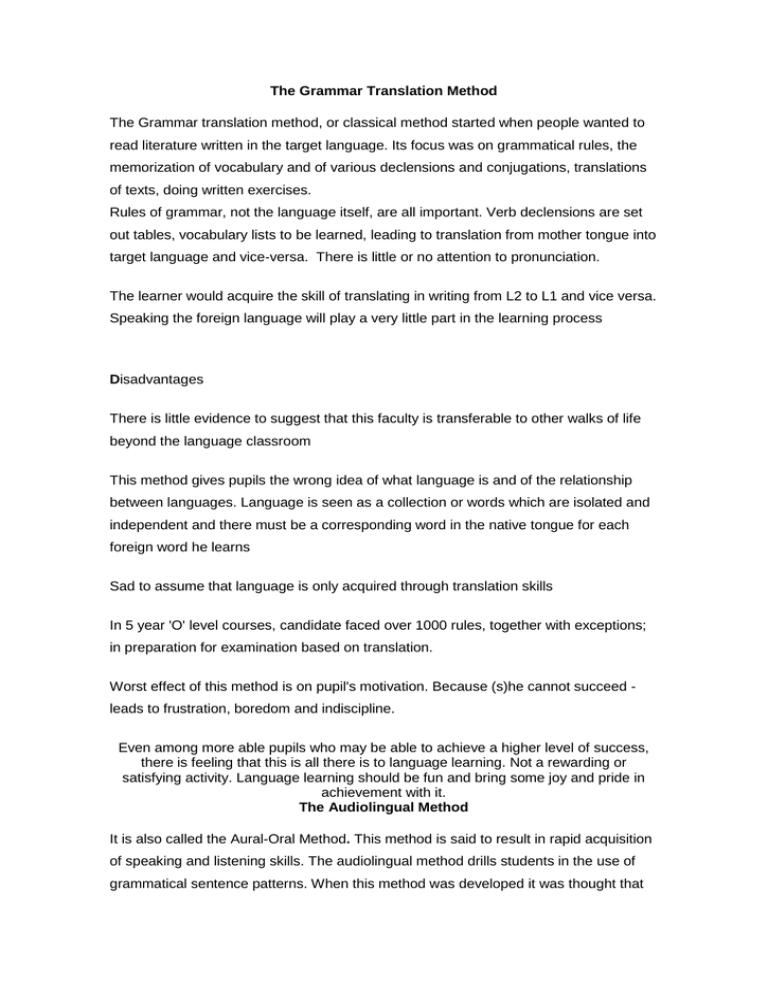
The Grammar Translation Method The Grammar translation method, or classical method started when people wanted to read literature written in the target language. Its focus was on grammatical rules, the memorization of vocabulary and of various declensions and conjugations, translations of texts, doing written exercises. Rules of grammar, not the language itself, are all important. Verb declensions are set out tables, vocabulary lists to be learned, leading to translation from mother tongue into target language and vice-versa. There is little or no attention to pronunciation. The learner would acquire the skill of translating in writing from L2 to L1 and vice versa. Speaking the foreign language will play a very little part in the learning process Disadvantages There is little evidence to suggest that this faculty is transferable to other walks of life beyond the language classroom This method gives pupils the wrong idea of what language is and of the relationship between languages. Language is seen as a collection or words which are isolated and independent and there must be a corresponding word in the native tongue for each foreign word he learns Sad to assume that language is only acquired through translation skills In 5 year 'O' level courses, candidate faced over 1000 rules, together with exceptions; in preparation for examination based on translation. Worst effect of this method is on pupil's motivation. Because (s)he cannot succeed leads to frustration, boredom and indiscipline. Even among more able pupils who may be able to achieve a higher level of success, there is feeling that this is all there is to language learning. Not a rewarding or satisfying activity. Language learning should be fun and bring some joy and pride in achievement with it. The Audiolingual Method It is also called the Aural-Oral Method. This method is said to result in rapid acquisition of speaking and listening skills. The audiolingual method drills students in the use of grammatical sentence patterns. When this method was developed it was thought that the way to acquire the sentence patterns of the second language was through conditioning or helping learners to respond correctly to stimuli through shaping and reinforcement. The Audiolingual Method is based on: Speaking and listening competence preceded reading and writing competence. The development of language skills is a matter of habit. Students practice particular patterns of language through structured dialogue and drill until response is automatic. The printed word must be kept away from the second language learner as long as possible. There is dependence on imitation, memorization of set phrases, and overlearning. Structures are sequenced by means of contrastive analysis taught one at a time. Structural patterns are taught using repetitive drills. There is little or no grammatical explanation. Grammar is inductive Great importance is attached to pronunciation.. Success responses are immediately reinforced. Very little use of the mother tongue by teacher is permitted Dialogues are the basic form of materials in the Audiolingual method. The dialogue serves three functions: a) illustrates the target structure; b) illustrates the situation the structure may be used; c) provides cultural information for language use wherever possible. In this method, oral interaction was emphasized in pattern drills, and conversation practices. Desuggestopedia The suggestive-desuggestive process allows students to go beyond previously held beliefs and self-limiting concepts concerning the learning process and learn great quantities of material with ease and enjoyment. . SUGGESTOPEDIA is the study of these suggestive factors in a learning situation. There are two basic kinds of suggestion: direct and indirect. Direct suggestions are directed to conscious processes. * an anti-suggestive emotional barrier which rejects anything likely to produce a feeling of lack of confidence or insecurity: “This antisuggestive barrier proceeds from the set-up in every man.” * an anti-suggestive barrier of man’s rational faculty which through reasoning rejects suggestions it judges unacceptable: ‘This barrier is the conscious critical thinking’. ”It is clear that the suggestive process is always a combination of suggestion and desuggestion and is always at an unconscious or slightly conscious level.” Students can sense when we embody the values and attitudes we “talk about”. Intonation is strongly connected with the rest of the suggestive elements. “Learning is state of mind dependent”. When varying your voice you “reach” different “states of mind”. The artistic organisation of the suggestopedic educational process creates conditions for concert pseudopassivity in the student. The concert pseudopassivity (concentrative psychorelaxation) overcomes the antisuggestive barriers, creating a condition of trust and infantilization in the student, who in a naturally calm state accompanied by a state of meditation without special autogenic training can absorb and work over a huge quantity of information. Music can be played as the students enter the room, and during the breaksMusic as a suggestive, relaxing medium. Lozanov researched a wide variety of means for presenting material to be learned which would facilitate the mentally relaxed, receptive state of mind he had found to be optimal for learning. Music can become a powerful facilitator of holistic full-brain learning. For the second concert presentation of material Lozanov found that Baroque music was especially suited. Direct Method It focuses on oral language, requires that all instruction be conducted in the target language with no recourse to translation. Reading and writing are taught from the beginning, although speaking and listening skills are emphasized--grammar is learned inductively. It has a balanced, four-skill emphasis. Instead grammar should be acquired inductively by inducing the rules of how the language behaves from the actual language itself. Never tell the children anything they can find out for themselves Direct Method based on belief that knowing a language was being able to speak it. Second language learning must be an imitation of first language learning, as this is the natural way humans learn any language, and so L2 has no place in L1 lesson. Printed word must be kept away from second language learner for as long as possible Disadvantages of Direct Method It is a longer method and most of the times time is not enough First language learning is essential part of child's total growth of awareness of The Direct Method rejects use of the printed word - but this objection is illogical since second language learner has already mastered his reading skills. Explanations may become troublesome and time-consuming.. Teachers would be jumping over desks flapping fins, rather than say that the English for 'saumon' is 'salmon'. Successful teacher of the Direct Method needed competence in his language / stamina/ energy/ imagination/ ability and time to create own materials and courses beyond capacity of all but gifted few. THE SILENT WAY Caleb Gattegno founded "The Silent Way" as a method for language learning in the early 70s, sharing many of the same essential principles as the cognitive code and making good use of the theories underlying Discovery Learning. Some of his basic theories were that "teaching should be subordinated to learning" and "the teacher works with the student; the student works on the language". The most prominent characteristic of the method was that the teacher typically stayed "silent" most of the time, as part of his/her role as helper, and thus the method's popular name. Language learning is usually seen as a problem solving activity to be engaged in by the students both independently and as a group, and the teacher needs to stay "out of the way" in the process as much as possible. The Silent Way is also well-known for its common use of small colored rods of varying length and color-coded word charts expressing pronunciation values, vocabulary and grammatical model Objectives Teachers using the Silent Way want their students to become highly independent and experimental learners. Making errors is a natural part of the process and a key learning device, as it is a sign that students are testing out their hypostheses and arriving at various conclusions about the language. Another key objective is to encourage students to work as a group - to try and "solve" problems in the target language together. This method is used expecting that students would eventually be able to actively use the language for self-expression, relating their thoughts, feelings and perceptions. Community Language Learning This methodology, also called "Counceling-Learning, is not based on the usual methods by which languages are taught. The approach is patterned upon counseling techniques and the personal and language problems a person encounters in the learning of foreign languages. The native instructors of the language are considered as language counselors. Curran's philosophy dictated that students were to be thought of as "clients" - their needs being addressed by a "councelor" in the form of the teacher The language-counseling relationship begins with the client's linguistic confusion and conflict. The aim of the language counselor's skill is first to communicate an empathy for the client's threatened inadequate state and to aid him linguistically. What is first needed is for the members to interact in an interpersonal relationship in which students and teacher join together to facilitate learning in a context of valuing and prizing each indiviual in the group. Then slowly the teacher-counselor strives to enable him to arrive at his own increasingly independent language adequacy. This process is furthered by the language counselor's ability to establish a warm, understanding, and accepting relationship, thus becoming an "other-language self" for the client. Community Language Learning seeks to encourage teachers to see their students as "whole persons", where their feelings, intellect, interpersonal relationships, protective reactions, and desire to learn are addressed and balanced. Students typically sit in a circle, with the teacher (as councelor) outside the ring. They use their first language to develop an interpersonal relationship based on trust with the other students. When a student wants to say something, they first say it in their native language, which the teacher then translates back to them using the target language. The student then attempts to repeat the English used by the teacher, and then a student can respond using the same process. This technique is used over a considerable period of time, until students are able to apply words in the new language without translation, gradually moving from a situtation of "dependence" on the teacher-councelor to a state of independence.
